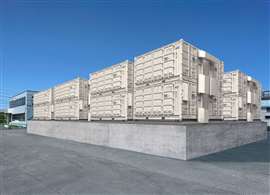NGK supply major battery storage system
26 July 2023
69.6 MWh platform planned for Japan
 NGK will supply NAS batteries for an energy storage facility of Sala Energy in Japan. (Image: NGK)
NGK will supply NAS batteries for an energy storage facility of Sala Energy in Japan. (Image: NGK)
NGK Insulators will supply NAS batteries for a Sala Energy energy storage facility in Japan.
The NAS batteries have a capacity of 69.6 MWh and can store electrical power equivalent to one day’s worth of electric power consumption by approximately 6000 average households, NGK said. The batteries will be directly connected to the electrical power grid at the SALA Hamamatsu Storage Station, which is located in Hamamatsu City. They are intended to stabilize the supply and demand of electrical power by storing electrical power when there is an excess supply and discharging it during shortages.
Sala Energy plans to use energy stored in the batteries for trading in various electricity markets such as the supply and demand adjustment markets and capacity markets, as well as reducing the cost of procuring electrical power through arbitrage via the wholesale electrical power market. It is expected that the NAS batteries will help to stabilize the supply and demand of electrical power, along with contributing to the expanded use of renewable energy, which can fluctuate significantly.
NAS batteries are rechargeable storage batteries that incorporate anodes (negative electrode) comprised of sodium (Na) and cathodes (positive electrode) comprised of sulfur (S), separated by a fine ceramic solid electrolyte. They can be repeatedly charged and discharged through sulfur-sodium chemical reactions. According to NGK, the batteries feature large capacity, high energy density (compact), and long life, and can provide a stable supply of electric power with a high output over long periods of time. They have been installed at over 250 locations worldwide, with a total output of over 720 MW and total capacity of approximately 5000 MWh installed. They are used for various applications, including peak shaving through load balancing and emergency power supply, as well as stabilization of renewable energy and construction of smart grids, thereby contributing to reduced environmental load and realization of carbon neutrality
Although the further introduction of renewable power generation, including solar and wind power, is anticipated as part of efforts to achieve carbon neutrality, the fact that the amount of power generated is affected by seasons and weather presents a challenge for renewable energy. Furthermore, managing the tightening supply and demand of electrical power due to factors such as climate change has become a social issue. Charging and discharging batteries for grid storage in line with supply and demand for electrical power can help to solve these issues.
STAY CONNECTED




Receive the information you need when you need it through our world-leading magazines, newsletters and daily briefings.
POWER SOURCING GUIDE
The trusted reference and buyer’s guide for 83 years
The original “desktop search engine,” guiding nearly 10,000 users in more than 90 countries it is the primary reference for specifications and details on all the components that go into engine systems.
Visit Now
CONNECT WITH THE TEAM










